We continue looking at configuring a K0005 wheelchair to an individual. So far we've discussed seat-to-floor height, seat slope, ergo seat, foot support-to-seat-length, front frame angle, seat width, front seat width, footrest width, and seat sling depth. Today we're looking at frame depth, seat back height, and seat-to-back angle.
Frame Depth
The frame depth is the distance along the seat tube from the front of the back post to the front frame bend. The front frame bend is usually lined-up directly above the center of the front caster when it’s in the trailing position. The frame depth is measured from the front of the back cane to the front frame bend. The center point of the trailing front caster is usually lined up with the front frame bend, resulting in a balanced wheelchair for optimal stability and propulsion.
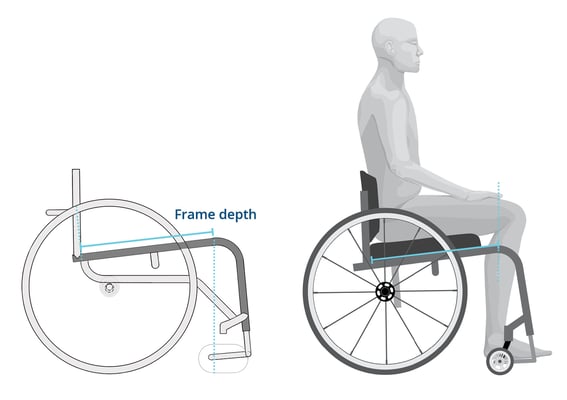
Frame depth on a rigid wheelchair should be set so that the bend in the frame lines up with the bend in the user's leg – where the thigh and the calf touch or popliteal fossa. This results in a balanced ride because, when the rear axle and the front caster are positioned properly via frame length, the wheelbase will be proportional to the user’s body. Wheelbase is the distance from where the rear wheel touches the ground to where the front caster touches the ground.
| * If you notice anterior instability, caster loading, or impaired maneuverability, check the frame depth! Caster loading means that too much weight is on the front casters, instead of the rear wheels. 75-80% of the user’s weight should be positioned over the rear axle of the chair. If the user complains that their old w/c is difficult to roll or turn or tips forward, consider moving the rear axle forward and adding some frame depth to their new w/c. |
Seat Back Height
Proper back height in a K0005 is important for providing appropriate postural support and upper extremity function for propulsion.
Seat back height measurement
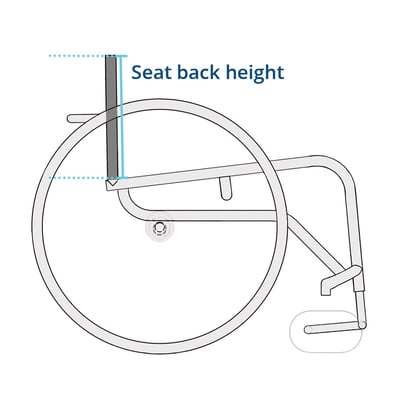 The WC measurement is from the top of the back post to the top of the seat tube at the back post.
The WC measurement is from the top of the back post to the top of the seat tube at the back post.
Select a seat back height that allows the prescribed back support to reach desired height to for adequate postural support.
An optimal back support height is determined by the highest point of the trunk needing support for stability and function.
| Back support - too high | Back support - too low |
|
May limit scapular movement during propulsion which impacts upper extremity range of motion |
May result in a feeling of instability Individual may slide into a posterior pelvic tilt seeking stability. This can increase peak pressures and promote abnormal posture |
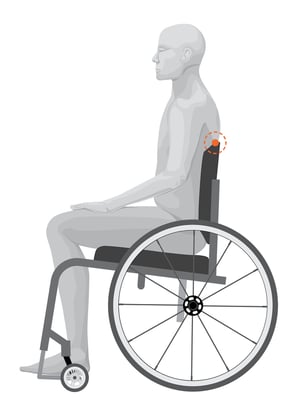 |
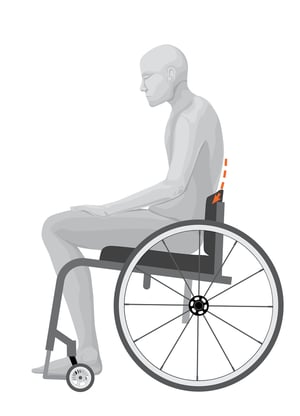 |
Seat-to-back angle
The seat-to-back angle (STBA) is critical for postural support and assuring the best position for efficient propulsion. Most adults need the STBA open a few degrees to allow room for their normal spinal curves. This angle can be further adjusted to the client's needs using adjustment on the back support mounting hardware and on the wheelchair itself if available.
STBA measurement
On the WC, seat-to-back angle is measured from the front of the back post to the floor.
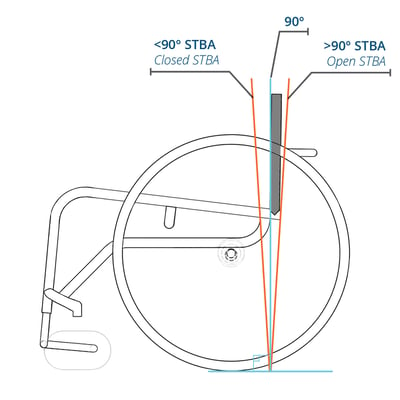
- Greater than 90° may improve postural stability for individuals with impaired trunk control and/or limitations in hip range of motion. 92° - 93° back post angle, combined with an appropriate back support, will help provide appropriate lumbar support, promoting normal spinal curves.
 Stacey Mullis, OTR/ATP
Stacey Mullis, OTR/ATP
Director of Clinical Marketing
Stacey serves as Director of Clinical Marketing for Permobil. A practicing OTR for over 20 years, she has experience in school-based pediatrics, inpatient rehabilitation, long term care, and home health. With her interest in wheelchair seating and positioning, Stacey engaged the challenges of providing appropriate seating in various clinical settings. She now uses this experience to develop programs and resources to educate clinicians on the principles of seating and wheeled mobility. She is passionate about equipping clinicians and through her previous role as Director of Clinical Education with Comfort Company and now with Permobil she has taught nationally and internationally to increase therapist capacity in this specialty area. Mullis graduated from Western University in London, Ontario, Canada with a BA Linguistics and BSc Occupational Therapy. She is a member of the NCOTA, CTF Executive Board, NRRTs, RESNA, and AOTA.
 Ginger Walls, PT, MS, NCS, ATP/SMS
Ginger Walls, PT, MS, NCS, ATP/SMS
Director of Clinical Sales and Education
Ginger has 25 years of experience as a physical therapist in the area of neuro rehab and wheelchair seating/mobility. She directed the Outpatient therapy clinics and the Seating/Mobility Program at Medstar National Rehabilitation Hospital in Washington, D.C. Additionally, Ginger has provided a variety of continuing education courses and lectures in the area of seating/mobility for many years. She has presented at major industry conferences including ISS, RESNA, and the PVA Summit. Ginger took on the role of Clinical Education Specialist for Permobil in 2015 and was appointed Director of Clinical Sales and Education in 2020.
